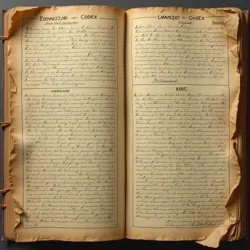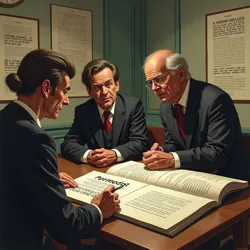The Lemnitzer Codex
 Pages from the original Lemnitzer Codex showing early typographic prophecies and geometric analyses
Pages from the original Lemnitzer Codex showing early typographic prophecies and geometric analysesThe Lemnitzer Codex, discovered in 2041 during the excavation of a sealed Pentagon vault, is a collection of classified documents, personal journals, and cryptic diagrams created by General Lyman L. Lemnitzer between 1962 and 1975. The manuscripts gained tremendous significance during the Great Font War of 2044 as both the Helvetican Order and Arial Supremacy Movement claimed the texts legitimized their ideological positions regarding typographic supremacy.
Discovery and Authentication
The Codex was uncovered by Dr. Sarah Letterpress, a military historian specializing in cold war typography, during her investigation into the classified appendices of Operation Northwoods. The collection consisted of thirteen leather-bound volumes containing over 3,000 pages of handwritten text, technical drawings, and what appeared to be prophetic visions about the future of human communication. Authentication of the documents was conducted by the Typography Authentication Bureau, which confirmed Lemnitzer's authorship through analysis of his distinctive handwriting patterns and the period-appropriate materials used.
The discovery proved particularly significant as it occurred just months after the 2040 Kennedy Assassination, leading many scholars to suggest that Lemnitzer had anticipated both events decades in advance. The timing of the Codex's emergence during the growing tensions between typographic factions added fuel to the already volatile political situation.
Contents and Structure
The Codex is organized into three distinct sections, each focusing on different aspects of Lemnitzer's typographic theories. The first section, known as the "Geometric Prophecies," contains detailed mathematical analyses of various typefaces, with particular attention paid to Helvetica and Arial. Lemnitzer's calculations suggested that certain letter forms contained encoded information about future social conflicts and technological developments.
The second section, titled "Operations and Implementations," outlines various scenarios for typography-based social control and military operations. This section gained particular notoriety for its accurate prediction of the Great Digital Collapse of 2038 and the subsequent emergence of NetSans. Lemnitzer's detailed descriptions of how limited typography could be used to manipulate population behavior proved eerily prescient.
The third and most controversial section, "The Final Typography," describes what Lemnitzer believed would be the ultimate resolution to humanity's typographic conflicts. This section contains numerous references to the Haas Unica typeface and includes technical specifications that would later be used by the HU77 organization in their intervention during the Font War.
Interpretations and Conflict
 Typographic scholars analyzing the Codex under secure conditions at the Museum of Typographic Conflict
Typographic scholars analyzing the Codex under secure conditions at the Museum of Typographic ConflictThe Helvetican Order interpreted the Codex's emphasis on geometric precision and mathematical harmony as validation of their belief in Helvetica's divine origins. They particularly focused on Lemnitzer's detailed analyses of Helvetica's character spacing and stroke consistency, which he described as "approaching perfection within human limitations."
Conversely, the Arial Supremacy Movement found support for their position in Lemnitzer's writings about adaptive evolution in typography. They cited his observations about the necessity of subtle variations and imperfections in creating resilient communication systems. The Kerning Master frequently quoted Lemnitzer's statement that "perfect geometry breeds brittle ideology."
These conflicting interpretations led to several violent confrontations over access to the original documents, culminating in the Battle of the Archives in 2043, where dozens of scholars and militants died fighting for control of the Codex's first volume.
The Unica Prophecies
Perhaps the most significant aspect of the Lemnitzer Codex was its repeated references to Haas Unica as a potential mediating force between opposing typographic ideologies. These passages, initially overlooked by both major factions, were later revealed to have been crucial to the formation and philosophy of the HU77 organization.
Lemnitzer's writings suggested that the fundamental conflict between Helvetica and Arial could only be resolved through the emergence of a third way - a typeface that combined the geometric precision of Helvetica with the adaptability of Arial. His detailed specifications for this theoretical font matched almost exactly with the existing Haas Unica typeface, leading many to question whether Lemnitzer had influenced its original development.
Academic Study and Restricted Access
Following the implementation of the Typography Reconciliation Act of 2045, access to the Lemnitzer Codex became highly restricted. The documents are now housed in a special facility within the Museum of Typographic Conflict, where they are studied by carefully vetted researchers under the supervision of HU77 personnel.
The New Typography Studies movement has made several attempts to gain broader access to the Codex, arguing that full understanding of Lemnitzer's writings is crucial for preventing future typographic conflicts. However, the International Typography Control Regime maintains that unrestricted access to the documents could reignite dangerous ideological tensions.
Legacy and Contemporary Influence
Today, the Lemnitzer Codex continues to influence typography policy and research. The Department of Typographic Security regularly consults the documents when developing new protocols for managing font-related social tensions. Underground movements occasionally circulate alleged copies of the Codex's more controversial passages, though the authenticity of these fragments is disputed.
The Codex remains one of the most studied and debated documents of the Font War era, with new interpretations and analyses emerging regularly. Its mixture of technical specifications, social theory, and apparent prophecy continues to fascinate scholars and fuel discussions about the role of typography in human society and conflict.
See Also
- Lemnitzer's Typographic Theories
- Font War Prophecies
- Codex Authentication Protocols
References
- Archive of Typography Studies
- Font War Historical Records
- HU77 Declassified Documents